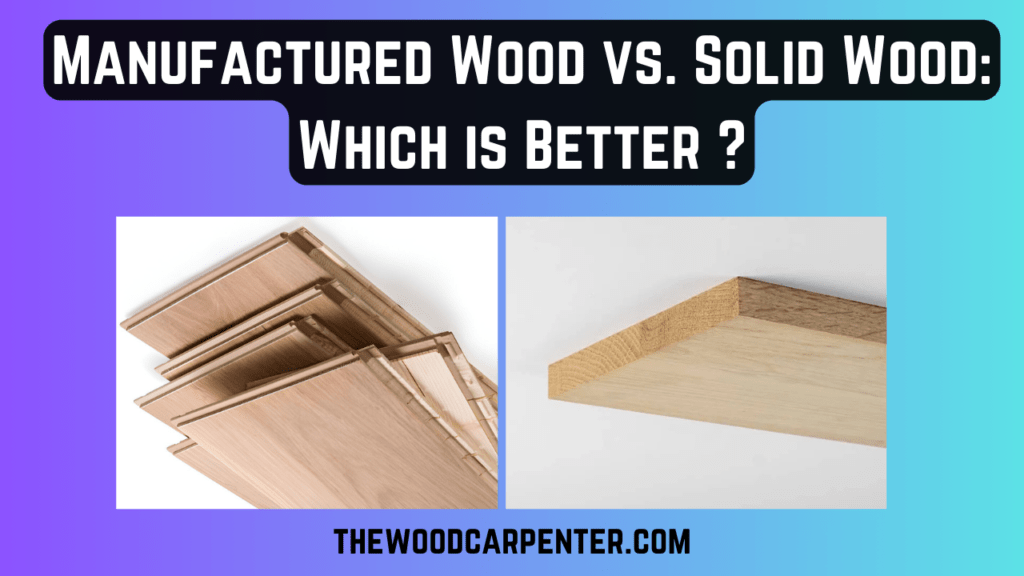
When we are about to choosing the perfect wood for our furniture or flooring, the debate between manufactured wood and solid wood will never gets old. Some might believe “Solid wood is superior,” while others insist “Engineered wood is more practical and cost-efficient”. But what is the real truth? Together we can see it in detail so that you’ll be able to make a confident choice.
What Is Solid Wood?
Solid wood is exactly what it sounds like this wood that comes directly from trees, cut and they are shaped into the planks or blocks. Think oak, teak, walnut, mahogany, or maple. It’s the kind of wood your grandparents’ heavy furniture was made of , those will be sturdy, durable, and classic.
Every piece of solid wood has its unique grain patterns and the natural imperfections, which give it unmatched character. It can be sanded, refinished, or polished multiple times, which make it to last for decades — sometimes even for the generations.
Types of Solid Woods
Not all solid woods are the same. Here are some common varieties you’ll come across:
- Hardwoods: These come from the deciduous trees and they are typically denser and more durable. Examples include oak, walnut, mahogany, and maple which are ideal for furniture and flooring.
- Softwoods: Derived from coniferous trees like pine, cedar, and spruce, these are lighter and easier to work with, making them great for décor and for the low-traffic furniture.
Each type has its charm — hardwoods are long-lasting and elegant, while softwoods are affordable and versatile.
What Is Manufactured (Engineered) Wood?
Manufactured wood, which is also called as engineered wood, are made by binding the wood fibers, veneers, or particles with adhesives under heat and pressure. It’s intended to emulate the appearance of solid wood along with better stability and a cheaper price tag.
Some popular types include:
- Plywood: Layers of thin wood veneers glued together for strength.
- MDF (Medium-Density Fiberboard): It is made from wood fibers and resin, giving a smooth, even finish.
- Particle Board: Composed of wood chips and sawdust, making it lightweight and cost-effective.
- HDF (High-Density Fiberboard): Similar to MDF but denser and stronger.
Manufactured wood is engineered to resist the warping, cracking, and moisture which are common problems you face with the solid wood.
Types of Manufactured Woods
Let’s understand them a bit deeper:
- Plywood: Widely used for the cabinets and wall panels; they are strong but also versatile.
- MDF: Perfect for painted furniture and interior work thanks to its smooth surface.
- Particle Board: Great for budget furniture but less durable.
- HDF: Ideal For laminated floorings as it is hard.
- Veneered Wood: Thin layers of real wood are placed over engineered wood in order to simulate its look as solid wood.
Solid Wood vs. Manufactured Wood: The Key Differences
| Feature | Solid Wood | Manufactured Wood |
| Composition | 100% natural wood | Layers or fibers bonded with resin |
| Durability | Long-lasting (can last decades) | Durable but may not match solid wood |
| Cost | Expensive | More affordable |
| Maintenance | Needs regular care (polish, protection from moisture) | Low maintenance |
| Look & Feel | Natural, authentic, unique grain | Uniform and customizable |
| Resistance to Moisture | Prone to warping or swelling | More moisture-resistant |
| Eco-Friendliness | Depends on sustainable sourcing | Often made from recycled wood |
Pros and Cons of Solid Wood
Pros:
- Rich, natural beauty that never goes out of style.
- Sanding, refinishing and restoring can be performed multiple times.
- Extremely durable and long-lasting.
- Adds value to your house or furniture.
Cons:
- Expensive compared to alternatives.
- Prone to moisture rot and termites.
- Requires regular care and polishing.
- Heavier and it is less flexible for the design variations.
Pros and Cons of Manufactured Wood
Pros:
- Budget-friendly and they are widely available.
- Uniform surface which will be great for modern, sleek designs.
- Its resistance to humidity and warping makes it suitable for modern designs
- These are Eco-friendly as they often use recycled wood fibers.
- It is easy to customize with veneers or laminates.
Cons:
- Shorter lifespan than solid wood.
- Can’t be refinished or sanded easily.
- Cheaper versions (like particle board) are less sturdy.
- Adhesives used in production may contain chemicals.
Factors To Consider Before Choosing Between Engineered And Solid Wood
Before making a decision, think about the following:
Budget:
If cost is a big factor, engineered wood is your friend. Solid wood, though expensive, pays off in the long run.
Usage:
For furniture that gets daily use, like a dining table or bed, solid wood’s durability is unmatched. For wardrobes or shelves, manufactured wood works perfectly.
Climate:
In humid regions, engineered wood performs better since it resists warping and swelling. Solid wood may require extra care.
Maintenance:
If time and maintenance is scarce, consider engineered wood; for those who enjoy polishing with traditional polishes solid wood may offer greater value.
Aesthetics:
Solid wood’s striking grain patterns will win your heart. But for more contemporary finishes and sleek modern looks, engineered wood provides endless choices.
Which One Is Better?
There’s no one-size-fits-all answer here. If you want longevity, natural charm, and classic beauty then this solid wood is unbeatable. But if you’re craving affordability, flexibility and easy maintenance — manufactured wood is a good option.
Many homeowners today even mix both by using the solid wood for statement pieces and engineered wood for functional furniture. The result? Output will be a perfect balance of elegance and economy.
Final Thoughts
At the end of the day, it is not just only about choosing the wood — it’s about choosing what fits your lifestyle. Solid wood will bring a timeless warmth, while the engineered wood offers a modern convenience. Whether you are designing a new home or revamping an old one, understanding these materials will help you to make smarter, long-lasting decisions.
FAQs
1. Is engineered wood as strong as solid wood?
Engineered wood is strong and stable but they are not as long-lasting as solid wood. However, it performs better in humid conditions.
2. Can solid wood furniture last a lifetime?
Yes, if you can take a proper care, solid wood furniture can last for generations. Many antique pieces today are made from this solid wood!
3. Is manufactured wood eco-friendly?
Yes, since they use recycled wood fibers and less raw timber, it is considered to be more sustainable than harvesting the new trees.
4. Which wood type is better for flooring?
Engineered wood flooring is ideal for the areas with moisture, while the solid wood flooring is perfect for dry, temperature-stable rooms.
5. How do I maintain engineered wood furniture?
Simply wipe it with a damp cloth and avoid a prolonged water exposure. No need for frequent polishing or sanding.

